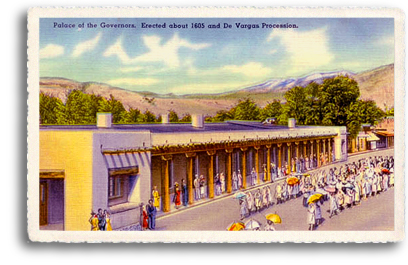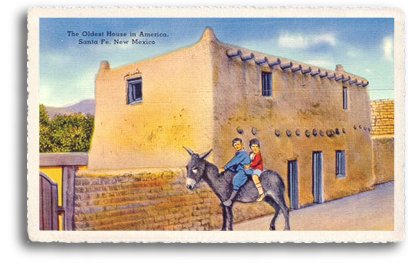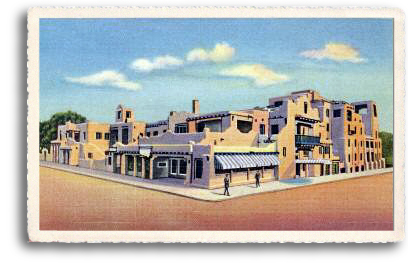 |
||
| The Historic Adobe Architecture of Santa Fe, New Mexico Today, many of Santa Fe’s 400-year-old structures still stand, and they are found throughout a number of areas in what could be called the “inner city.” Considering that the construction material used in these buildings is vulnerable to summer rains and winter snows, it speaks volumes for the long-lasting architectural miracle called adobe.  The Plaza Area The Plaza AreaThe Palace of the Governors This adobe structure (pictured right) dates back to the early 17th century and is the oldest public building in the United States. In 1610, Pedro de Peralta, the newly appointed governor of the Spanish territory covering most of the American Southwest, began construction on the Palace of the Governors. In the following years, the Palace changed hands as the territory of New Mexico did, seeing the Pueblo Revolt of 1680, the Spanish reconquest from 1693 to 1694, Mexican independence in 1821, and finally American possession in 1846. The Palace originally served as the seat of government of the Spanish colony of Nuevo Mexico, which at one time wad comprised of the present-day states of Texas, Arizona, Utah, Colorado, Nevada, California, and New Mexico. After the Mexican War of Independence, the Mexican Province of New Mexico was administered from the Palace of the Governors. When New Mexico was annexed as a U.S. territory, the Palace became New Mexico's first territorial capitol. During the American Civil War, the building also briefly served as the Confederate Army's regional headquarters. In 1909, when the New Mexico state legislature established the Museum of New Mexico, the Palace of the Governors became a state history museum. This extraordinary example of adobe architecture was designated a Registered National Historic Landmark in 1960 and an American Treasure in 1999. The Palace of the Governors is located at 105 West Palace Avenue. Museum of Fine Arts The Museum of Fine Arts was founded in 1917 as the Art Gallery of the Museum of New Mexico. This building is considered by many to be the jewel in the crown of the newer adobe architecture in the downtown area.Its Pueblo Revival style clearly set the standard for historic preservation in Santa Fe. The building was designed by I. H. and William M. Rapp, and was based on their New Mexico building at the Panama-California Exposition of 1915. The adobe structure combines aspects of several Southwestern regional styles, including elements of the facades of the Spanish mission churches of Acoma, Laguna and San Felipe Pueblos.  For more than eighty-five years the Museum has collected and exhibited work by artists from New Mexico and around the world. The Museum of Fine Arts is located at 107 West Palace Avenue. For more than eighty-five years the Museum has collected and exhibited work by artists from New Mexico and around the world. The Museum of Fine Arts is located at 107 West Palace Avenue.Burro Alley Once the city’s bawdy nightlife district, featuring cantinas, saloon and gambling establishments (and also home to “ladies of the night”), ironically, this tiny street is named for the burros (pictured right) that carried firewood to be sold there. Burro Alley is located between San Francisco Street and Palace Avenue. Old Santa Fe Trail The Oldest House Known as the oldest house in America (pictured right), it certainly offers a whiff of charm akin to the olden days. Small and quite dark inside, the authentic adobe brick  construction offers a cool repose from a hot Santa Fe summer day. Across the street from the Oldest Church (located at 401 Santa Fe Trail), it makes for an easy double tourist-trip back in time. Located at 215 East De Vargas Street. construction offers a cool repose from a hot Santa Fe summer day. Across the street from the Oldest Church (located at 401 Santa Fe Trail), it makes for an easy double tourist-trip back in time. Located at 215 East De Vargas Street.Barrio de Analco Located in the East De Vargas Street area, these small adobe buildings were homes in the nation’s oldest neighborhood, founded in 1610 by Mexican Indian soldiers and Spanish colonists. This district is generally recognized as the second-oldest settlement section in the city. Plenty of true Santa Fe charm can be found here. Barrio de Analco is located south of the Santa Fe River. La Fonda Hotel Once a famed Harvey House, the hotel (pictured right) was built in 1922 on the site of earlier hotels at the end of the Santa Fe Trail. Many special events are held here throughout the year, giving locals a reason to visit this  wonderful, welcoming landmark. Located at 100 East San Francisco Street. wonderful, welcoming landmark. Located at 100 East San Francisco Street.Also in the area: The Oldest Church East of the Plaza These adobe buildings with their charming courtyards were once spacious family homes. Today, these serve as wonderful examples of the early adobe architecture that has become synonymous with with “Santa Fe style.” Canyon Road Once an Indian game trail leading to the Pecos Pueblos and then an art colony in the 1920s, this street is now internationally famous for its art galleries. As one of Santa Fe’s oldest neighborhoods, some of the best examples of authentic adobe architecture can be found here. Canyon Road begins at Paseo de Peralta. El Zaguan The fortified-style house, built with four-foot-thick walls, and featuring a public Victorian garden, is an authentic example of 19th-century Santa Fe architecture. A sprawling Territorial hacienda, this massive adobe structure houses the offices of the Historic Santa Fe Foundation. The large and beautiful flower garden is named for noted archaeologist Adolph Bandelier, who studied the ancient Pueblo Indians, and is honored by the nearby national monument that bears his name. He was one of many illustrious residents of El Zaguan. The house is located at 545 Canyon Road. Randall Davey House Listed in national, state and city registers of historic and cultural buildings, the Randall Davey House is part of the New Mexico Audubon Center. The 16-inch-thick stone walls are now covered by plaster, but the massive, roughly hewn, beamed ceilings of the mill are still visible. The mill's former storeroom was converted to an art studio by Randall Davey. He added large north-facing windows, which look out on the slopes of Santa Fe Canyon. The property was originally part of the Talaya Hill Grant given in 1731 to Manuel Trujillo. Situated three miles from the Plaza, it was primarily used for grazing and woodcutting until the U.S. Army quartermaster built a stone sawmill here in order to provide lumber for the building of Fort Marcy. In 1852, the property was sold to the well-known trader and trapper Colonel Ceran St. Vrain for $550. In 1856, St. Vrain sold the mill machinery to Joseph Hersch and Isaiah Smith who established a new mill downstream on the Santa Fe River. The property then passed through a series of owners, including Captain Candelario Martinez who purchased it in 1892. Martinez was an attorney, postmaster and probate judge in Santa Fe. During his ownership the land was cultivated in corn, oats, alfalfa and fruit trees. In 1920, Randall Davey purchased the property and converted the sawmill into his home. He lived and painted here for the next 44 years. Two murals, "Burros Eating Pears" and the frog on the studio door, were both painted by Davey soon after acquiring the property. Also is this area: Cristo Rey Church Guadalupe Street  Barrio de Guadalupe Located in the South Guadalupe Street area. There were once small farms here during Spanish Colonial times. Later, during the heyday of the railroads, it was the commercial hub of the city. The houses found here now are some of the oldest in the Santa Fe, as this neighborhood grew out from the historic Plaza district. Historic Railyard District Now a upgraded commercial park, the railyard houses museums, shops, restaurants and the local Farmer’s Market. The historic depot building (pictured right) has been carefully preserved. On the streets branching off from the railyard are some fine examples of early adobe architecture. Located on South Guadalupe Street. Also in this area: Santuario de Guadalupe According to Home Advisor professionals, adobe buildings are most common in the desert climate of the Southwest but other locations throughout the U.S. can benefit from the flexibility of adobe construction. The Home Advisor website may be a valuable aid in finding a Home Advisor approved builder familiar with adobe construction. |
||
Home | Food | Lodging | Merchants | Services | Real Estate | Art & Galleries | Entertainment | Recreation Ski Areas | Mind-Body-Spirit | Santa Fe Information | Local Color | Canyon Road | The Turquoise Trail | Santa Fe Plaza The Pueblos | Scenic Beauty | Day Trips | Chili | Special Events | Santa Fe History | Multicultures | Museums High Road to Taos | The Wild West | Churches | Plants & Wildlife | Santa Fe Railyard | Turquoise | Architecture Fiesta | Indian Market | Spanish Market | Zozobra | Features | About Us | Get Listed! | Santa Fe Unlimited Trading Post Photo of the Week | Link of the Month | Testimonials | Santa Fe Webcams | Santa Fe Weather Santa Fe A to Z | Movie Locations | Santa Fe Unlimited Guestbook | Sitemap | Contact Us | Taos Unlimited |
||